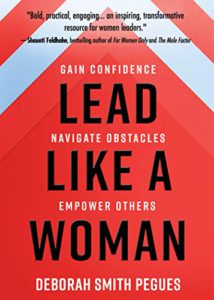BORN TO LEAD–LIKE A WOMAN: PART 1
 “It’s a girl!” From the moment you were born, gender socialization began. Socialization, the process by which we learn how to behave based on societal norms and values, is the basis for the gender stereotypes that you must deal with for the rest of your life. Socialization starts with your parents and is perpetuated by relatives, teachers, and other influencers, who reinforce the different expectations for female versus male roles.
“It’s a girl!” From the moment you were born, gender socialization began. Socialization, the process by which we learn how to behave based on societal norms and values, is the basis for the gender stereotypes that you must deal with for the rest of your life. Socialization starts with your parents and is perpetuated by relatives, teachers, and other influencers, who reinforce the different expectations for female versus male roles.
For centuries, we have been socialized to view leadership as a man’s domain. Women who have entered this sacred realm face a double bind: maintaining their femininity while skillfully crossing the stereotype line and being assertive and strong. For some people, both men and women, the idea of a powerful female is still too much to accept as a norm. But things are changing, albeit slowly. When I read World Economic Forum’s December 2018 report, projecting that it will take another 200 years to close the gender gap at work on a worldwide basis, I knew I had to do something. Write something… something that would inspire women to pursue an individual track to fulfilling their callings and careers. After all, we are born to excel in leadership.
From the beginning, God instructed man and woman to function as equal, interdependent partners. In Genesis 1:28 (NKJV), He said to them, “Be fruitful and multiply; fill the earth and subdue it. ” Neither Adam nor Eve could achieve this mandate independently of each other. They were going to have to work together. This was the grand plan not just in the context of marriage but in the operation of the planet. Despite what you have read, heard, or experienced in society and religion, know that men and women can only be “fruitful” (producing good results or being profitable) when they work together. Yes, the sexes are different in their design and qualities, but they must begin to see their differences as complementary rather than conflicting.
Over the past four decades, the increase in female leaders has produced new approaches to the exercise of leadership. Women’s leadership styles have been shown to be more transformative, participative, and inclusive than the leadership styles of their male counterparts. According to the results of a 2008 Pew Research initiative studying whether men or women make better leaders, participants stated that women possessed the top eight leadership characteristics, including honesty and intelligence, by a ratio of five to one when compared to participants’ rating of men.
But despite accounting for nearly half of the workforce in the United States—and more than half of the middle-management positions—women are still rare among CEOs of the largest corporations. Is there any hope? Stay tuned for Part 2…


